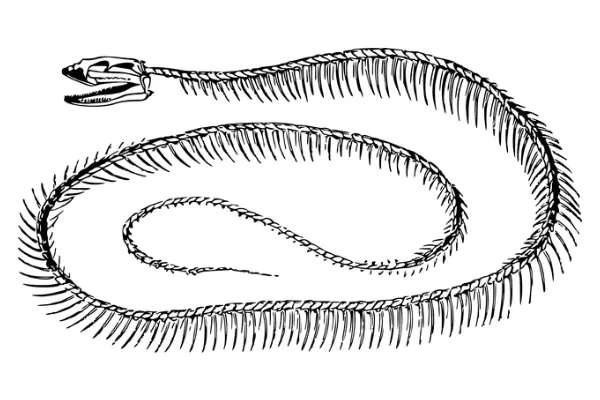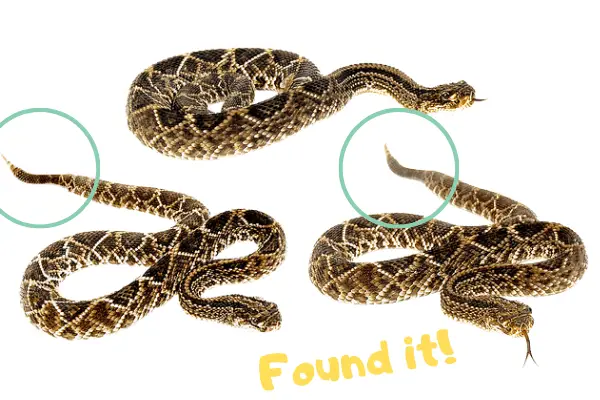If you’re someone who likes to ponder on the deeper mysteries of life, you have probably asked yourself: Do snakes have tails? Well, in this article, we at Urban Reptiles are going to help you out by answering this strange yet interesting question.
Well, snakes do have tails. The various kinds of species play an essential role in the importance and length of their tails. The tail of some species snakes does not even have a purpose. They do not add anything either to their outer look or their survival mechanism. Apart from the rattlesnake, which has a rattling tail to warn of potential predators and to let them know that the rattlesnake is aware of any their presence.
Some may have guessed it, others might have thought that snakes only have bodies. Both are fair arguments to make. However, to really answer the question of whether snakes have tails, we need some more information…
Table of Contents
What Is Classified As The Snake’s Tail?
Typically, the tail is the furthest thing at the back of the body of an animal. It generally protrudes from the rest of the body quite a bit further. Even though it is pretty obvious to tell in some animals, it is difficult to identify them in snakes and distinguish where it ends because of their bodily structure.
However, one particular factor helps you determine the start of their tails. The ribs on the snake’s body safeguard the vital organs within. But, quite interestingly, those organs no longer need protection in the tail section.
This means that the tail is just an additional body component, and the ribs no longer need to protect the organs.
As snakes move around a lot with their body, the organs inside them require protection by the ribs. There are ribs along the whole length of their body, but they cease at a certain point on their bodies. This is because there are no more organs in the rest of the body to guard.
If you study their skeletons, you will notice that the ribs stop at the very edge of their bodies in certain snakes. Whereas, in others, it ends only halfway up the body.
Wikipedia even gives some more information about a snakes tail too. It says that the tail is the part of the snake that doesn’t contain any vital internal organs.
Once we take a look at a snakes skeleton, we can see where the ribs stop. No ribs means no protection to the organs and thus, no organs.

As you can see, this would mean that a snake’s tail starts surprisingly far down its body. It’s a long way away from where most would guess it was. It’s often thought that a snake’s tail starts halfway down its body, but, as you’ll see in the next part, some snakes have a really clear tail.
Where does a snake’s tail start?

In this image, you can clearly see where the snakes tail starts. It actually looks rather funny when you notice it for the first time. It’s kind of like there’s a little snake stuck inside of a larger one.
Can A Snake Lose Its Tail?
You can often see animals that lose their tails but still survive in nature and seem healthy. However, this case is different with snakes. If a genuine snake species loses its tail, it will not be able to live for long. This is especially if a large portion of their tails falls off instead of only a small part by the very end.
Initially, the snake’s tail would not grow back from their bodies again. Moreover, there may be complications linked to the injury of the place where the tail was removed could result in the snake’s death. There is a legless lizard that resembles a snake but is not. They usually do not possess tails, and even if they do and it falls out, they will still survive and even grow their tails back.
What Is A Snake’s Tail Used For?
You might be curious to discover what the tails are used for. Unlike other animals, snakes do not have the distinct function of balancing or keeping bugs at a distance. Instead, snake tails help them to protect themselves and capture things as they do not have limbs.
Yes, they can clutch things with their tail. They can also use it to defend themselves from predators. Not only this, but the snake can also hang by grabbing a branch or a section of a tree with its tail from this posture. You will often spot climber snakes that do this frequently, utilizing their tails almost like a limb.
On the other hand, snakes also use their tails to bind themselves around prey. Sometimes when snakes are hungry, they use their tail to ambush their prey instead of doing it with their mouth and jaws. They will then stay in that position until the prey has suffocated and died. Overall, the more the snake requires its tail, the more prominent the tail appears on its body.
Tails of Males Snakes Longer Than The Females?
The length of their tails varies depending on the species. Even though the length of the bodies of both female and male snakes are the same, male snakes have significantly larger tails than females. This is because the organs in the male body are more varied than the females, so they have more capacity in their bodies for the tails to take up space.
Another reason for this is that males with longer tails appear to have an advantage in reproduction. In comparison, snakes with shorter tails have a more challenging time mating and reproducing, according to some research. In addition, compared to other animals, it can be far more problematic if a snake loses its tail.
It also depends on the extent to which the injury was sustained on the snake’s tail. If it is a small one, then the snake can still survive by proper and immediate treatment. However, apart from proper research, you will notice that the tail length of male and female snakes is roughly the same. To be sure if females have shorter tails, you will have to look at skeleton images of the snake to check if its tail is as long as you believe it is.
Why Do Some Snakes Have Rattle Tails?
There are a lot of rattlesnakes that inhabit this planet. You can mainly spot them in dense forests. But, you may ask, why do these snakes have rattle tails? Well, the rattle in their tails is due to a defensive reaction to predators around them. The rattle is built up of a sequence of intertwined keratin segments that are also hollow. These are generated by altering the scales that cover the tail’s tip.
This means that the presence of a third party in their territory makes these snakes unhappy, due to which they rattle their tails, indicating the intruder to leave. Thus, to warn approaching rivals, the snake has evolved this exceptionally advanced warning system. In reality, rattlesnakes are thought of as the latest and most developed snakes in the family of reptiles.
Rattlesnakes are the most dangerous species of snakes. The snake’s terrifying hiss is amplified by the shrill rattle. Apart from this, rattlesnakes also coil their slithering bodies and lift their heads up in the air to oppose and indicate that they are not terrified of their intruders. However, they rarely rattle as they usually ambush their enemies from their back.
Conclusion
By now, you know the answer to your question, do snakes have tails? Yes, they do, and it is an essential part of their body as it helps them fight off predators and grab objects that they can’t in other ways as they have no limbs. Thanks for reading the whole article.
Hopefully, now you can distinguish between the tail and the body of a snake. Remember to steer clear of rattlesnakes and let them do their own thing whenever you come across one.
